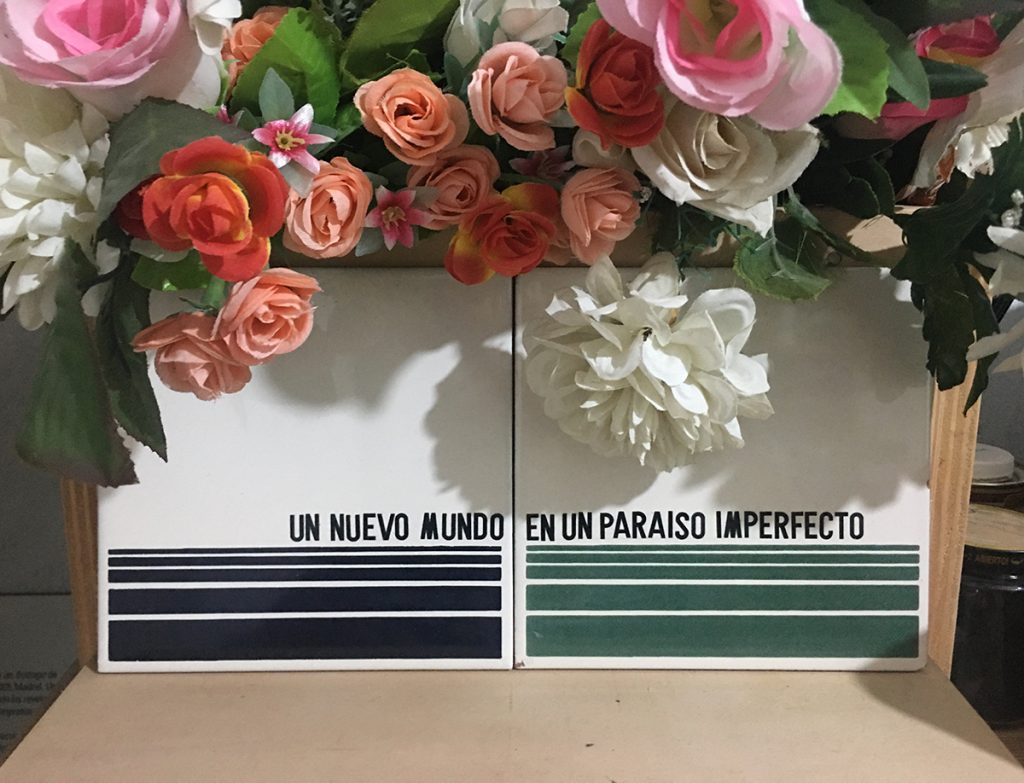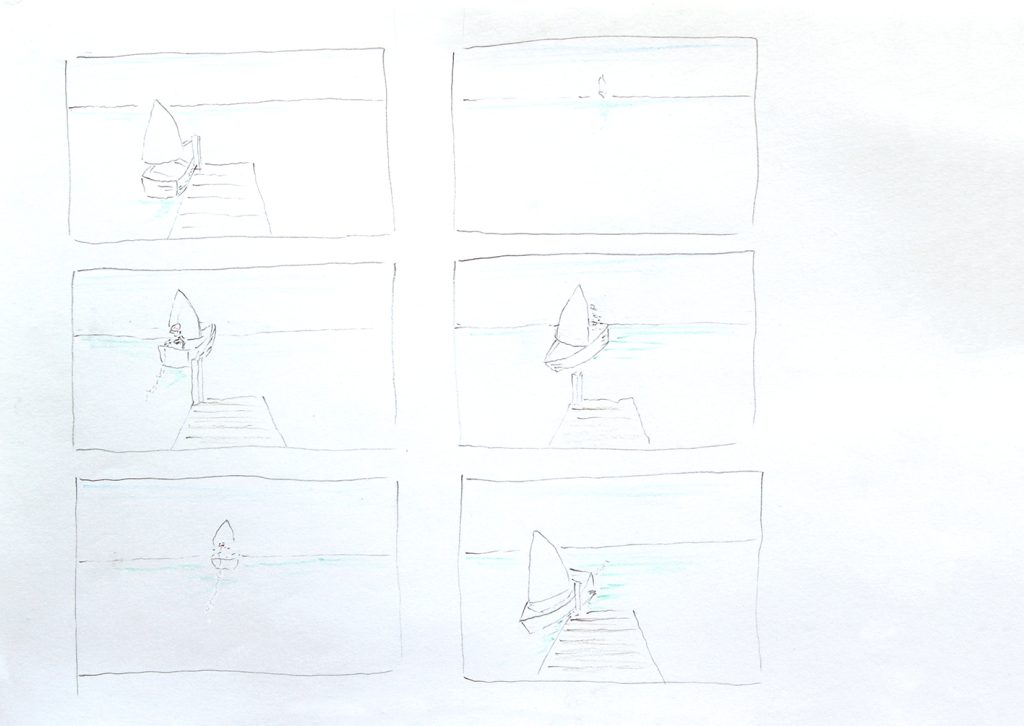
Un nuevo mundo en un paraíso imperfecto. Proyecto para una videoanimación. 2020…
En proceso
“En el verano de 2020 crucé lentamente el Estrecho de Gibraltar, dejando trás de mí una fina estela de grafito sobre el mar, polvo sobre agua. Mientras yo avanzaba, el mineral desaparecía lentamente. ¿Sería movido ad aeternum por esas corrientes submarinas invisibles, o se hundiría hasta depositarse para siempre sobre el fondo marino, testigo mudo de una acción de la que no quedaría rastro alguno?
A new world in an imperfect paradise. Project for a video animation. 2020…
In progress
«In the summer of 2020 I slowly crossed the Strait of Gibraltar, leaving behind me a thin trail of graphite on the sea, dust on water.
a thin trail of graphite on the sea, dust on water. As I advanced, the mineral slowly disappeared. Would it be moved ad aeternum by those invisible underwater currents, or would it sink to settle forever on the seabed, a mute witness to an action of which no trace would remain?»
Juan Carlos Brach

Un nuevo mundo en un paraíso imperfecto* consta de una doble pantalla/proyección. En cada una de ellas se asiste a una acción que he decidido abordar desde el dibujo animado.
Unir mediante una línea de dibujo/grafito las dos orillas del Estrecho de Gibraltar -que sería el camino más corto entre dos puntos- se convierte así en un nuevo horizonte que define inesperadamente otra idea de frontera. Al mismo tiempo se defife el limes que separa lo de dentro y lo de fuera, las tierras cultivadas y las de los bárbaros, el hortus conclusus y la selva selvaggia, En definitiva esa acción se convierte en un trazo capaz de unir ambos espacios físicos y simbólicos, Europa y África, el Primer Mundo y los otros mundos.
Las dos pantallas muestrarán una misma escena desde cada una de esas dos orillas: un personaje -alter ego animado de nu mismo- se sube a una embarcación, y mientras el viento lo empuja hacia el otro lado, va dejando caer polvo de grafito desde la popa, con la intención de trazar sobre el agua una línea que sin remedio cae al fondo, ya por completo desdibujada…
La acción, eminentemente alegórica, nos habla de la imposibilidad última de trazar marcas sobre la superficie/mapa de una Tierra compartida, al tiempo que una serie de voces en off dialogan en castellano, inglés, francés y arabe (lenguas todas ellas que se entrecruzan y se mezclan en ese lugar de tránsito desde la antiguedad). Así el espectador, sumergido en tal viaje de ida y vuelta, y esa multiplicidad de personajes -interpretados todos por mi- deberá atribuir a esos sujetos una encarnación, o proyectarse en cualquiera de ellos. Juntos, actores y espectadores, reconstruirán el periplo desde múltiples puntos de vista: sus causas y consecuencias, sus derivas, amén de otras historias paralelas que surgirán revelándose en el camino.
El vídeo aúna la sencillez de un dibujo al borde de lo esquemático (véase el storyboard adjunto) con la de la propia acción, tan sucinta: mientras en una pantalla la barca se aleja de la tierra hasta desaparecer, en la otra, simétricamente, va creciendo desde un punto en el horizonte hasta el desembarco. Pero a esta animación de apariencia tan sencilla se le añade una intensa carga emocional con esas voces fuera del plano que juegan y dialogan entre ellas, sin alcanzar ningún desenlace narrativo, sumando capas de significado que se cruzan y entrelazan
Un nuevo mundo en un paraíso imperfecto se plantea, pues, como una exploración de toda frontera entre lo real y lo imaginario. Relato múltiple, contado a partir de una serie de narraciones que discurren paralelas a una secuencia lineal y simétrica. Allí el espectador se ve invitado a participar preguntándose dónde se encuentra él mismo ante dicho relato, y por su ubicación en este cruce rodeado de reflejos, historias individuales y sueños colectivos.
En definitiva, Un nuevo mundo en un paraíso imperfecto reflexiona sobre la idea de horizonte/frontera como espacio físico y mental; un lugar siempre presente pero que no alcanzaremos jamás, mientras que se dibuja como límite o un más allá íntimamente relacionado con el otro, lo diferente, con el viaje, el sueño y la utopía.
*La estética de la animación de este nuevo trabajo seguirá la estela dejada por La Boule de niege. Historia de un fracaso
oA New World in an Imperfect Paradise* consists of a double screen/projection. In each of them an action takes place, which I have decided to approach from the point of view of animated drawing.
Joining by means of a drawing/graphite line the two shores of the Strait of Gibraltar – which would be the shortest way between two points – thus becomes a new horizon that unexpectedly defines another idea of frontier. At the same time, the boundary that separates the inside and the outside, the cultivated lands and those of the barbarians, the hortus conclusus and the jungle jungle, is defined. In short, this action becomes a line capable of uniting both physical and symbolic spaces, Europe and Africa, the First World and the other worlds.
The two screens will show the same scene from each of these two shores: a character – the animated alter ego of nu himself – gets into a boat, and while the wind pushes him towards the other side, he drops graphite dust from the stern, with the intention of tracing a line on the water that falls hopelessly to the bottom, now completely blurred?
The action, eminently allegorical, speaks to us of the ultimate impossibility of tracing marks on the surface/map of a shared Earth, while a series of voice-overs dialogue in Spanish, English, French and Arabic (all of them languages that intertwine and mix in this place of transit since antiquity). Thus the spectator, immersed in this journey back and forth, and this multiplicity of characters – all played by me – will have to attribute an incarnation to these subjects, or project himself into any of them. Together, actors and spectators will reconstruct the journey from multiple points of view: its causes and consequences, its drifts, as well as other parallel stories that will emerge and reveal themselves along the way.
The video combines the simplicity of a drawing bordering on the schematic (see the attached storyboard) with that of the action itself, so succinct: while on one screen the boat moves away from the land until it disappears, on the other, symmetrically, it grows from a point on the horizon to the landing. But to this apparently simple animation is added an intense emotional charge with those voices outside the shot that play and dialogue with each other, without reaching any narrative denouement, adding layers of meaning that cross and intertwine.
A New World in an Imperfect Paradise is thus an exploration of every frontier between the real and the imaginary. It is a multiple story, told through a series of narratives that run parallel to a linear and symmetrical sequence. There, the spectator is invited to participate by asking himself where he finds himself in this story, and where he stands at this crossroads surrounded by reflections, individual stories and collective dreams.
In short, A New World in an Imperfect Paradise reflects on the idea of the horizon/border as a physical and mental space; a place that is always present but which we will never reach, while it is drawn as a limit or a beyond intimately related to the other, the different, to the journey, the dream and utopia.
The aesthetics of the animation of this new work will follow in the wake of The Boule de niege. History of a failure
